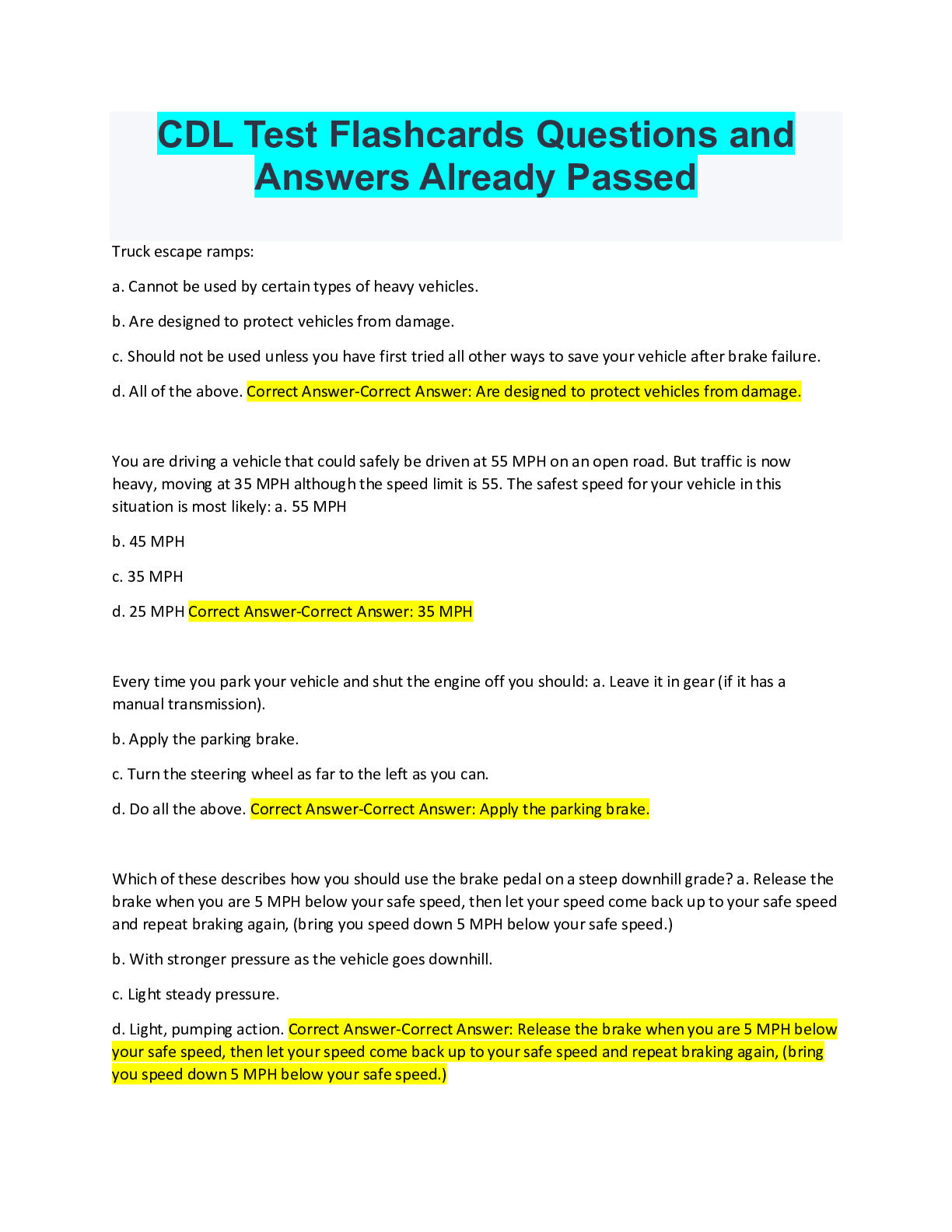*NURSING > QUESTIONS & ANSWERS > ATI - Vital Signs Pretest Questions and Answers 100% Pass (All)
ATI - Vital Signs Pretest Questions and Answers 100% Pass
Document Content and Description Below
ATI - Vital Signs Pretest Questions and Answers 100% Pass You have assessed a 45-year-old patient's vital signs. Which of the following assessment values requires immediate attention? A. An oral t... emperature of 100° F (37.8° C) B. A blood pressure of 148/88 mm Hg C. A respiratory rate of 30/min D. A radial pulse rate of 45 beats per 30 seconds ✔✔C. A respiratory rate of 30/min A respiratory rate of 30/min is above the normal range and indicates a respiratory problem that requires immediate attention. An adult breathing at that rate might be experiencing shortness of breath or dyspnea and, without intervention, this could become a life-threatening situation. The difference between a patient's systolic and diastolic blood pressure is called A. The pulse deficit B. The pulse pressure C. An auscultatory gap D. a diurnal variation ✔✔B. The pulse pressure The difference between the systolic and diastolic pressures is the pulse pressure; if the patient's blood pressure is 130/85 mm Hg, the pulse pressure is 45/min. Pulse pressure can be a predictor of heart problems, especially in older adults. For example, an elevated pulse pressure usually reflects stiffness and reduced elasticity of the aorta, most often due to hypertension or atherosclerosis. To auscultate a patient's apical pulse accurately, you position the bell or the diaphragm of your stethoscope over the point of maximal impulse which is located A. at the right midclavicular line B. over the suprasternal notch C. over the Angle of Louis D. at the fifth intercostal space at the left midclavicular line ✔✔D. at the fifth intercostal space at the left midclavicular line To locate the point of maximal impulse, first locate the angle of Louis - a bony prominence just below the suprasternal notch. Slide your fingers down each side of the angle of Louis to locate the second intercostal space. Gently move your fingers down the left side of the sternum to the fifth intercostal space and laterally to the left midclavicular line. You have found the PMI. When assessing a patient's respiration, it is recommended that the patient A. have the head of the bed elevated 45 to 60 degrees B. take several deep breaths prior to the assessment C. lie flat in bed with his/her head on a pillow D. continue to go about his/her usual activities ✔✔A. have the head of the bed elevated 45 to 60 degrees This is a comfortable position for most patients and it allows full ventilatory movement. Also, any type of discomfort can increase respiratory rate. The most important factor in measuring blood pressure accurately is A. obtaining the reading in the early morning B. using a cuff of the appropriate size for the patient C. making sure the patient is comfortable and relaxed D. removing clothing from the arm before applying the cuff ✔✔B. using a cuff of the appropriate size for the patient Using the wrong cuff size for the patient will result in an erroneous reading. A cuff that is too small will result in a reading that is falsely high while a cuff that is too big will record a false low. One way to select a cuff is to make sure that the width of the cuff is 40% of the arm circumference where the cuff will be wrapped. The bladder (inside the cuff) should surround 80% of the arm circumference. When auscultating patient's apical pulse, you listen until you hear the S1 and S2 heart sounds clearly and regularly. S2 is produced when the A. atria contract vigorously B. ventricular walls vibrate C. semilunar valves close D. mitral valve snaps open ✔✔C. semilunar valves close The second heart sound, S2, is generated by the closure of the semilunar vales (the aortic and pulmonic valves) and signals the start of diastole. S2 is the "dub" heard in the normal "lub-dub" sound. You are preparing to use a tympanic thermometer. Which of the following steps has the highest priority in the accurate use of this piece of equipment for measuring body temperature? A. Replacing the thermometer in its charger B. Assessing the external ear for redness C. Gently pulling the pinna back and upward D. Attaching the disposable probe cover ✔✔C. Gently pulling the pinna back and upward This position helps straighten the ear canal and provides optimal access to the tympanic membrane. Good contact with sufficient tympanic membrane is essential for an accurate tympanic temperature measurement. When preparing to measure the vital signs o [Show More]
Last updated: 1 year ago
Preview 1 out of 6 pages
Instant download
.png)
Instant download
Reviews( 0 )
Document information
Connected school, study & course
About the document
Uploaded On
Oct 14, 2022
Number of pages
6
Written in
Additional information
This document has been written for:
Uploaded
Oct 14, 2022
Downloads
0
Views
69

.png)
.png)
.png)
.png)
.png)
.png)
.png)
.png)
.png)
.png)
.png)

.png)

.png)
.png)












